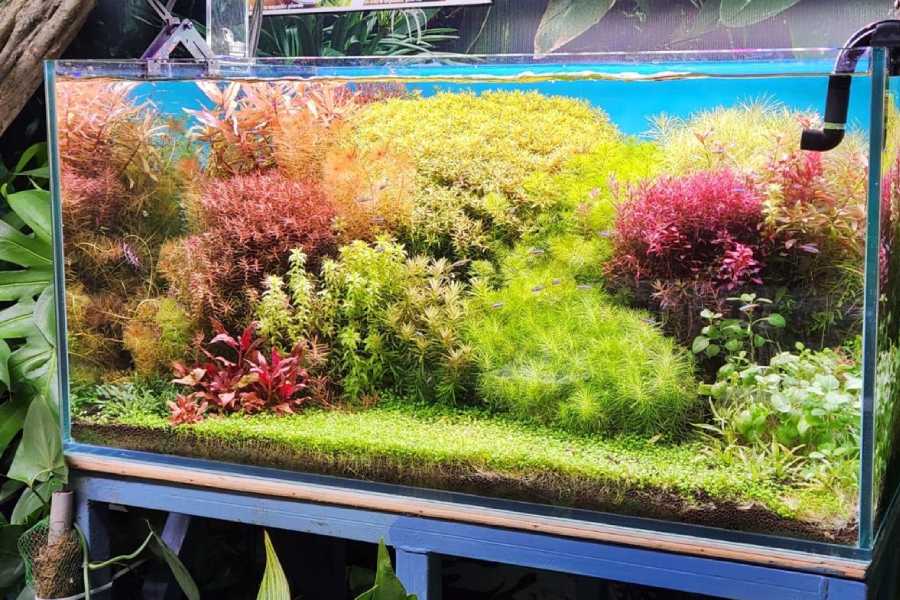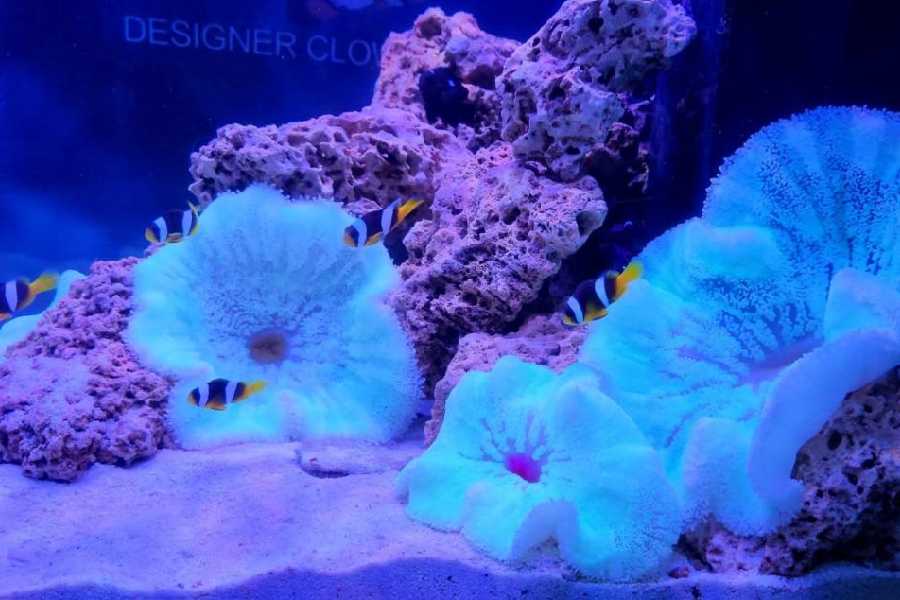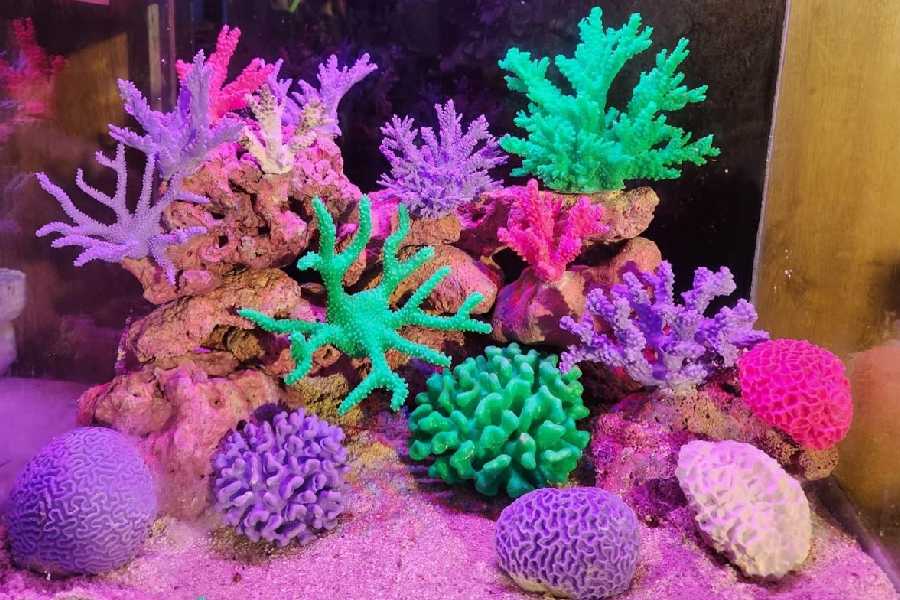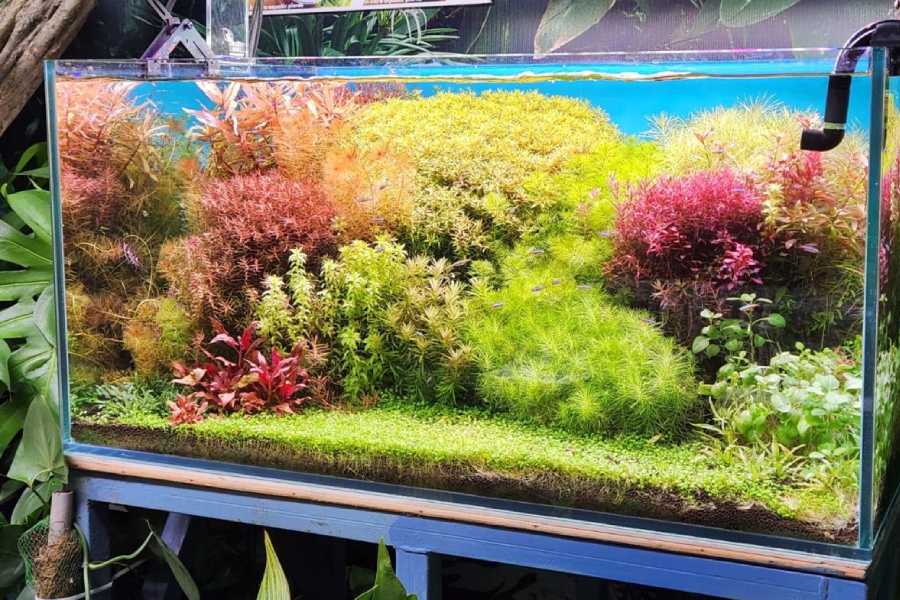The Kolkata Fish Federation’s fourth ornamental fish expo was a paradise for aquarium enthusiasts. Besides Goldfish, Flowerhorns and Bettas, the Science City show introduced Discus in the competitive category this year and there were a number of stalls and discussions on fish care and technology.
Sandeep Subramoniam, of Kerala’s Back Water Aquatics, shed light on aquascaping, the art of using rocks, wood, and plants to create underwater landscapes. “An aquarium can be a living piece of art but good aquascaping can be expensive — a 3-foot tank might cost around Rs 1.5 lakh,” he said, cautioning against low-quality options. “Cheap alternatives are a waste of money and it’s better to get into aquascaping once you can afford it.”
Ajinkya Chopade of Promeal, Maharashtra, showcased live insects and worms as a natural alternative to traditional pellets. “Most freshwater fish are insectivores, devouring mosquito larvae and the like in the wild. While pellets are convenient, they contain high amounts of corn and wheat. We supply live or packaged African and American beetle larvae, Turkish cockroaches etc that are closer to their natural diet,” he said.
Aquatic veterinarian Chairat Sunganthong had come from Thailand to discuss fish diseases. “Flowerhorns, for instance, are prone to pop eye (eye bulges) and duck mouth (swelling),” he said. “In Thailand, vet hospitals have aquatic sections, but not everyone is able to bring their fish over. So we promote social media pages where owners can share videos and receive help from vets. India could try the same.”
Ricky Sharma, the federation founder, lamented the lack of aquatic vets for the general public. “So fish owners turn to experienced individuals like us for advice,” he shared. “Keeping fish teaches kids responsibility and empathy. Instead of wasting money on cigarettes and drugs, youth who love fish invest in building beautiful aquariums. They learn to appreciate the vastness of our world, that belongs not just to humans, but plants and animals too.”

If you’ve only seen fresh water aquarium with Flowerhorns and Arowanas, the marine tanks would blow you away! The Lionfish, for instance, was a striking sight with long, venomous fins covering its body. The Moorish Idol was equally captivating, with its bold bands of white, yellow, and black. “Marine fish come in a far greater variety and array of colours, but require specialised equipment to thrive in saltwater aquariums,” explained Abhishek Choudhury, a marine biologist and the founder of Seascapes Creative’s Aquarium. He also educated listeners about the methods of obtaining marine fish. “Captive breeding of marine fish is difficult so most are wild-caught. Traditionally, fishermen would mix cyanide in an area known to have ornamental fish. This would render the fish unconscious, allowing them to be netted in great numbers,” explained Choudhury. “The fish would be revived with anti-cyanide, but these chemicals would end up killing 80 per cent of the catch and damage the surrounding marine life too.” Cyanide fishing is banned but continues on the sly. Choudhury says ethical stores like his now source marine fish through hand-catching methods. “Here, a diver descends some 300m into the ocean and catches a single fish at a time. It’s difficult and expensive, but sustainable."

Planted aquariums were some of the most stunning sights at the show. "Divide your tank into thirds horizontally and place your tallest plants in the back," suggested Subhajit Ghosh of Pallishree Nursery. "Fill the middle area with medium-sized plants for variation, and use only carpeting plants like grasses in the foreground. This layout provides space for the fish to swim where you can easily watch them."
This aquarium had Neon Tetras swimming about. "You need small fish for such aquariums as the big ones will pull the roots out," he said. "Good lighting and carbon dioxide levels will give the plants deep colour," added Ghosh.

The Carpet Anemone was perhaps the most underrated yet fascinating creatures at the show. Anemones are invertebrates that can perform photosynthesis but also eat plankton or fish. Unlike corals, anemones
have soft bodies and the ones at the show looked like flowers. The Anemones at Seascapes Creative's Aquarium shared a symbiotic relationship with Clownfish (star of the 2003 Disney film Finding Nemo) and Three Spot Damsel (a black fish with three white spots). "The Anemone cannot move, so these two species bring food and release it at its central mouth, which looks like the centre of a flower," explained Abhishek Choudhury. "They also clean it. In return, the Anemone provides these fish space to rest and hide from predators in its folds." The Anemone can distinguish when approached by any creature other than these two species and will then close its 'petals' like touch-me-not leaves and consume it," he explained, while demonstrating this by touching the Anemone.

Had it been legal, live corals would have enlivened your aquarium. Since it is not, why not get 3D-printed coral replicas instead? Corals are marine invertebrates that are crucial to life under the ocean and are now endangered by rising temperatures and sea levels. Hence it is illegal to remove them. "But their beauty is unparalleled and cannot be replicated by plastic molds. So, we came up with 3D printing of corals," said Suddhaditya Dev of Quality Discus. "We started 3D printing a month ago using Japanese machines. The material is a non- toxic polymer, safe for fish. A 10-inch piece takes about 20 hours to print and costs about Rs 1,500,"

A new entrant at the show this year was the Discus, a native of the Amazon river of Brazil. "This fish gets its name from its disc-like shape," said Anjan Das of Discus Dreams. "This fish is a highly social creature and we recommend people keep at least of six of them together so they can interact. "Discus are hardy fish as, even when unwell, they give you a fortnight for treatment." The prices of Discus range from Rs 1,000 to 1 lakh.
